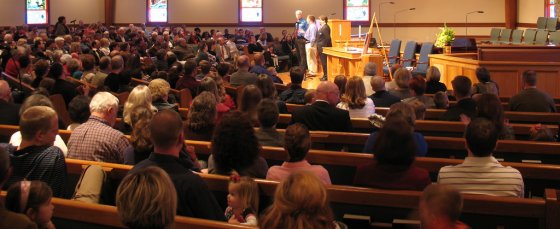A year and a half ago my family moved to a new neighborhood about a half-hour drive from where we used to live. Our synagogue, for which we’d been members for about eight years was no longer nearby. Without kids, that’s not a big deal, but now that we’re raising a family we needed to find a synagogue that was much closer.
Ours is a very common story that faith-based organizations see all the time. The decisions we make about which synagogue to join will be based on some tangibles, such as distance and the physical aspects of the synagogue, but we’ll be swayed by lots and lots of intangibles such as how much we “like” the community.
While faith-based organizations such as churches and synagogues can’t control how physically close they are to you, they can control many of the intangibles to improve your overall “feeling” of the organization. That got me to thinking about how faith-based organizations do recruiting and how some of those same techniques to manage the intangibles so you “like” the organization may or may not be appropriate for your business.
Real community verses faux community
 If you have enough experts talking about building your community then eventually everyone believes they actually have one.
If you have enough experts talking about building your community then eventually everyone believes they actually have one.
“The community as it’s often portrayed doesn’t actually exist. Sure, you have an audience, and a group of people who are interested in your content (not you, your content), but they’re not at all a community,” argued B.J. Mendelson (@bjmendelson), Author of Social Media is Bullshit.
Faith-based organizations do actually have communities which is actually a part of the product that they sell. Cultivating that community is the equivalent of growing the product, nurturing leads, and closing sales.
Conversely, every business that has a company page with a few followers on it believes they have a community. That’s not true. You have fans that are interested in your deals and maybe your content. They may have an interaction with fellow users, but most companies are not building a true community in the same way a faith-based organization builds a community.
How integral is your audience to your overall product? Yes, I know you love your customers and you’d do anything for them, but could your product exist without them?
Do people identify with other users of your product? Do they learn from each other? How active is that behavior? Could you encourage more?
Really long term strategy
Even though we joined another synagogue, we’re still members of our original synagogue where we’ve been members for eight years. That’s nothing for some members who have relationships that have lasted generations.
Faith-based organizations have no problem letting customers use many of their services for free, often for years. When someone does become a member, they become a member for life, and their family’s lives as well. That results in a constant and continuous revenue stream.
How long term is your business strategy? How comfortable are you offering your services for free and for how long?
Membership invites recruiting participation
 Once you become a member of a faith-based organization, you become a cog in the recruiting machine. That’s not meant to sound crass, but it’s rather an expected and welcome job as each member enjoys the process of being an integral part of the community. They recognize that their outreach is so critical to building the community.
Once you become a member of a faith-based organization, you become a cog in the recruiting machine. That’s not meant to sound crass, but it’s rather an expected and welcome job as each member enjoys the process of being an integral part of the community. They recognize that their outreach is so critical to building the community.
How can you not only convert each customer to be an advocate, but can you give them the authority and power to invite others into your circle to truly make it a community?
For example, when I purchased a high-end Canon video camera I spent a lot of time pouring over the manual and learning every single aspect of the camera. I would have loved it if a Canon customer who owned the same camera and knew it well called me and said, “Have any questions about that camera? I use it and I’m happy to help.” That would have been extremely effective and it would probably have inspired me to “pay it forward” to a future Canon camera owner.
Expectation of engagement
 Often when people talk about why they become members, they’ll speak to a moment of unexpected outreach that one member did for them. For example, when we became members of the new synagogue and a neighbor who I didn’t even know called me and just welcomed me to the temple and offered to be my liaison should I ever have any questions. She’s also not the first. We’ve had multiple welcome calls and multiple welcome gifts. The members have really gone out of their way to make us feel special and immediately a part of the community.
Often when people talk about why they become members, they’ll speak to a moment of unexpected outreach that one member did for them. For example, when we became members of the new synagogue and a neighbor who I didn’t even know called me and just welcomed me to the temple and offered to be my liaison should I ever have any questions. She’s also not the first. We’ve had multiple welcome calls and multiple welcome gifts. The members have really gone out of their way to make us feel special and immediately a part of the community.
Conversely, I was talking with one friend who was turned off by one synagogue because after attending two different services, not a single member came up and introduced him or herself to welcome them.
Having members introduce themselves to new potential recruits is an expected behavior in a faith-based organization. Conversely, when you visit Best Buy or The Gap, and they greet you at the door, it’s actually kind of irritating, and we often respond with a “just looking” response, making it clear we don’t want to engage. The greeting at a retail store is not an invitation to a community, but rather a required sales technique that will hopefully lead to a quick sale. We’re turned off by the behavior.
Most religious organizations don’t try to get you to become a member the moment you walk through the door.
Is it possible that you could be proactive about welcoming people to your organization in a low pressure no commitment manner?
Start at micro level before you go macro
 Becoming part of a large organization can be really intimidating. That’s why even the largest faith-based organizations are smart about making sure that all community interactions start at the micro level, or one individual making a connection to another.
Becoming part of a large organization can be really intimidating. That’s why even the largest faith-based organizations are smart about making sure that all community interactions start at the micro level, or one individual making a connection to another.
After that initial introduction you can start to invite people to participate in small groups and graduate up to even larger groups. My synagogue does this for one of its services. For new members, or people who are new and not even members, they invite them to a new member mixer just 30 minutes before the actual service. This small group of probably less than 20 people is a more comfortable environment to get accustomed to the throngs of 300-plus that attend services. It can be really intimidating to walk into a group of 300 people that seemingly all know each other and you don’t know anyone. An introduction to one person, then a small group of 20 is a good way to be eased into that kind of community.
Instead of waiting for a customer service call, how can you proactively reach out to new customers on a one-to-one, small group, and then to the entire group?
Are faith-based recruiting tactics right for your business?
In no way am I an expert on faith-based recruiting. I have just been the recipient and participant of tactics, and I’m appreciative of how effective they are. If faith-based recruiting can be so effective for so long, why haven’t other organizations adopted many of the same techniques? There are many obvious reasons why they don’t given the hugely divergent business models and goals, but I hope the supplied questions will get you to think about whether some of the same techniques could be usable in your own organization.
Creative Commons photo attribution to hoyasmeg, johnragai, and D G Butcher (2, 3)




